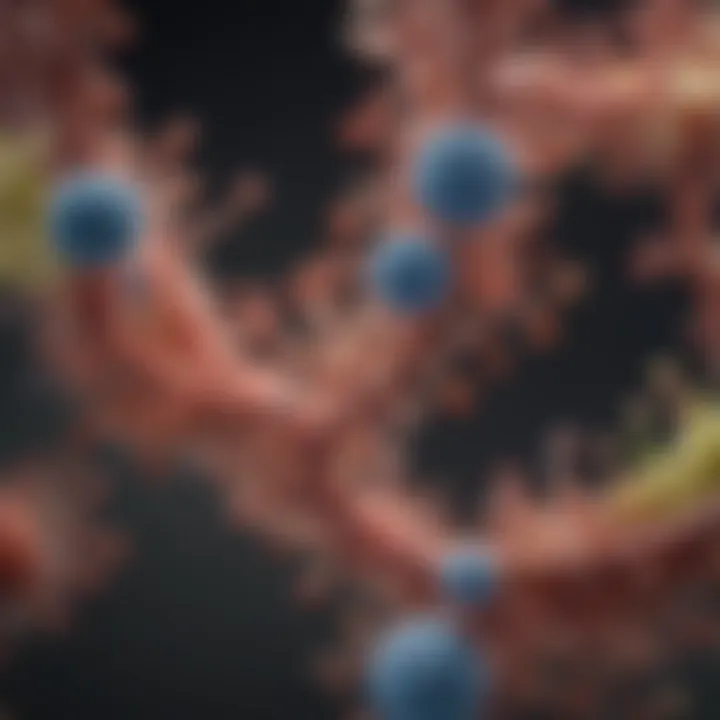Histamine Reducing Probiotics: Benefits and Mechanisms


Intro
Histamine intolerance is an increasingly recognized condition that affects many individuals. The imbalance of histamine levels can lead to a variety of health issues, including digestive disorders, headaches, and allergic reactions. In recent years, the interest in probiotics has grown significantly, particularly those that can help reduce histamine levels in the gut. Probiotics are live microorganisms that provide health benefits when consumed in adequate amounts, and specific strains have been identified as capable of modulating histamine metabolism. Understanding how these probiotics work is essential, not only for those suffering from histamine intolerance but also for professionals in the fields of nutrition and medicine.
This article will explore histamine-reducing probiotics in depth. It will elucidate the mechanisms through which these probiotics operate, examine the health benefits associated with their use, and summarize current research findings. Emphasizing the interactions between gut microbiota and histamine regulation, this article aims to equip readers with valuable insights into choosing the right probiotic strains for optimal health outcomes.
Research Overview
Summary of Key Findings
Research indicates that certain probiotic strains have the potential to degrade histamine and other biogenic amines. Lactobacillus rhamnosus and Bifidobacterium lactis have shown effectiveness in histamine metabolism. They produce enzymes that can break down excess histamine in the gut, making these strains particularly relevant for those with histamine intolerance. Additionally, the fermentation process can shift dietary components, potentially lessening the histamine load.
Shifts in gut microbiota composition due to the introduction of these probiotics have also been documented. A balanced gut microbiota contributes to improved histamine tolerance and potentially alleviates symptoms associated with histamine intolerance. Researchers have highlighted the need for further studies on specific dosages and long-term effects to validate these findings.
Importance of the Research
The growing prevalence of histamine intolerance demands a better understanding of probiotic interventions. This research is crucial for developing dietary guidelines that incorporate these beneficial bacteria. For healthcare professionals, staying informed about probiotics' mechanisms can lead to improved patient outcomes. Moreover, understanding the relationship between gut health and histamine management allows for more targeted approaches in treating gastrointestinal disorders and allergies.
Methodology
Study Design
Several studies exploring the role of probiotics in histamine reduction utilize randomized controlled trials (RCTs) and observational studies. RCTs are particularly valuable as they provide robust evidence on the effects of specific probiotics compared to control groups that do not receive the intervention.
Data Collection Techniques
Data collection typically involves questionnaires assessing symptoms related to histamine intolerance, as well as stool sample analysis to observe changes in gut microbiota composition. Researchers often measure levels of histamine and other metabolites before and after probiotic intervention, ensuring a comprehensive understanding of the probiotics’ effectiveness. Such meticulous methods enhance the reliability of the findings, contributing to the ongoing discourse surrounding gut health and histamine management.
Prolusion to Histamine and Probiotics
Histamine is a biologically active compound that plays a crucial role in various physiological processes in the human body. It is best known for its involvement in inflammatory responses and allergic reactions. An imbalance in histamine levels can lead to adverse health effects, particularly in individuals with histamine intolerance. This condition can manifest with symptoms such as headaches, gastrointestinal issues, and skin reactions. Understanding histamine and its regulation is therefore essential, especially in an age where more people are becoming aware of food sensitivities and intolerances.
Probiotics, on the other hand, are live microorganisms that provide health benefits when consumed in adequate amounts. These beneficial bacteria can impact gut health and beyond. They have garnered attention in recent years for their potential to modulate histamine levels in the body. The convergence of these two areas—histamine and probiotics—opens a pathway for exploring how certain probiotic strains can serve as a therapeutic option for those suffering from histamine-related issues.
Exploring this topic is significant not only for understanding the underlying mechanisms but also for drawing connections between dietary practices, gut health, and overall well-being. This article will delve into the specific mechanisms through which probiotics can influence histamine metabolism, along with insights into potential benefits and applications.
Understanding Histamine
Histamine's primary roles include the mediation of immune responses, regulation of stomach acid, and functioning as a neurotransmitter. It is synthesized from the amino acid histidine through a process mediated by the enzyme histidine decarboxylase. Once synthesized, histamine can either exert its effects or be broken down by other enzymes such as diamine oxidase and histamine-N-methyltransferase. The balance between synthesis and degradation is key. When histamine levels surpass the capacity for degradation, it can lead to symptoms commonly associated with histamine intolerance.
Moreover, histamine is present in various foods, especially those that are fermented, aged, or spoil easily. Individuals with compromised histamine metabolism or those who consume high-histamine foods may experience increased symptoms. The impact of gut bacteria on histamine levels is a relevant consideration. A healthy gut microbiome may help modulate histamine levels, and this is where probiotics may play a role in promoting a healthy gut environment.
The Role of Probiotics
Probiotics serve as vital players in maintaining gut health. These microorganisms can help restore the balance of the gut microbiota, which may become disrupted due to factors like poor diet, stress, and use of antibiotics. Certain probiotic strains are believed to possess histamine-reducing properties, offering potential therapeutic benefits.
Some strains, such as Lactobacillus plantarum and Bifidobacterium lactis, have been shown to degrade histamine directly, while others may enhance the overall health of the gut lining and immune responses, indirectly aiding in histamine metabolism.
By influencing gut microbiota composition and function, probiotics can help manage histamine levels, providing a natural approach to address histamine intolerance and related symptoms. This connection highlights the importance of selecting appropriate strains for therapeutic use and invites further research into the efficacy of these probiotics in clinical settings.
Histamine Metabolism in the Human Body
Histamine metabolism involves the intricate processes of synthesis, degradation, and regulation. Understanding these mechanisms is crucial to grasp how histamine intolerance occurs and how probiotics might play a role in mitigating its effects. Histamine is produced from the amino acid histidine, primarily in mast cells and basophils. Once released, histamine carries various functions, such as regulating local immune responses and acting as a neurotransmitter. Levels of histamine must be carefully controlled to maintain homeostasis. Overproduction or inadequate breakdown can lead to histamine intolerance, causing symptoms like headaches, gastrointestinal issues, and skin reactions.
The human body utilizes specific enzymes to degrade histamine. This degradation occurs chiefly in the liver and gut. Key enzymes, including histamine-N-methyltransferase and diamine oxidase, work continuously to prevent histamine from reaching harmful levels. If these pathways are disrupted or overwhelmed, health consequences may arise, highlighting the significance of maintaining effective histamine metabolism.
Moreover, the gut microbiota plays a pivotal role in histamine metabolism. The composition of gut bacteria can influence the synthesis and degradation of histamine. A balanced microbiota is essential for optimal functioning of these metabolic pathways. Disruptions to this balance can exacerbate histamine intolerance, making it essential for individuals to consider their gut health when addressing histamine-related issues.
Synthesis and Degradation Processes
Synthesis and degradation of histamine are tightly regulated processes involving several steps and enzymes. Once histidine is converted into histamine, it can either be utilized in physiological responses or be metabolized for removal. Key enzymes responsible for these reactions include:
- Histidine decarboxylase: This enzyme converts histidine to histamine. It is primarily found in certain neurons and mast cells.
- Histamine-N-methyltransferase (HNMT): This enzyme metabolizes histamine in the central nervous system and the liver. It adds a methyl group, altering its structure and activity.
- Diamine oxidase (DAO): This enzyme breaks down histamine in the digestive tract. Its presence is crucial for preventing excess histamine from entering the bloodstream.
Understanding these processes offers insight into potential therapeutic interventions. For instance, probiotics may modulate the activity of these enzymes or improve gut health, consequently affecting histamine levels.


Impact of Gut Microbiota
Gut microbiota significantly influences histamine metabolism through various mechanisms. The diversity and balance of gut bacteria play a role in the production and degradation of histamine. Some bacterial strains can produce histamine, while others have the capability to degrade it. This complex ecosystem can either contribute to histamine intolerance or help alleviate symptoms associated with it.
Studies have shown that individuals with histamine intolerance often exhibit altered gut microbiota composition. This imbalance may lead to increased histamine levels due to reduced degradation and impaired metabolism. Specific probiotics have demonstrated the ability to restore balance in the gut and, as a result, enhance histamine regulation.
Integrating probiotics into dietary practices may help offset imbalances within the microbiota. Probiotic strains like Lactobacillus rhamnosus and Bifidobacterium infantis have shown promise in studies related to histamine reduction. Understanding the impact of gut microbiota on histamine metabolism further emphasizes the importance of selecting appropriate probiotics to manage histamine intolerance effectively.
Probiotics and Histamine Regulation
The relationship between probiotics and histamine regulation is a crucial topic to explore within the context of histamine intolerance. Probiotics are live microorganisms that, when administered in adequate amounts, confer health benefits to the host. They play a significant role in balancing gut microbiota and can influence histamine levels in the body. Understanding the mechanisms through which these probiotics function is essential for those looking to mitigate the effects of histamine intolerance.
Histamine is a compound involved in various physiological functions, including the immune response and regulation of gastric acid secretion. However, excessive histamine levels can lead to adverse effects such as allergic reactions and digestive issues. Probiotics can help modulate these levels, making their application particularly relevant in clinical settings for patients suffering from histamine sensitivity.
Mechanisms of Action
Probiotics exert their histamine-lowering effects through several mechanisms. Firstly, certain strains can degrade histamine directly. For example, Lactobacillus rhamnosus and Lactobacillus plantarum have demonstrated the ability to produce enzymes that break down histamine, thus lowering its concentration in the gut. This enzymatic activity plays a vital role in managing histamine levels and alleviating symptoms.
Secondly, probiotics can influence the gut microbiome composition in a way that reduces the abundance of histamine-producing bacteria. An imbalanced gut microbiome often leads to increased production of histamine. By restoring microbial balance, probiotics can limit the presence of undesirable histamine-secreting bacteria, consequently managing overall histamine levels.
Moreover, the anti-inflammatory properties of probiotics contribute to reducing histamine's impact. When inflammation decreases, histamine-receptor activation can also decline, leading to fewer symptoms. Therefore, choices of specific probiotic strains can enhance histamine regulation in the body effectively.
Types of Probiotics with Histamine Reducing Properties
Not all probiotics exert the same effects on histamine levels. It is important to choose specific strains known for their histamine-reducing properties. Some relevant strains include:
- Lactobacillus rhamnosus: Known to produce enzymes that degrade histamine.
- Lactobacillus plantarum: This strain is effective at modulating histamine levels in the digestive tract.
- Bifidobacterium infantis: Helps in the breakdown of histamine and supports intestinal barrier function.
In addition to these strains, other species may also contribute to histamine regulation but require further research for validation. Being informed about which probiotics can effectively manage histamine is crucial for those exploring dietary adjustments or supplementation options.
Selecting the appropriate probiotics is essential. The effectiveness varies based on the strains and mechanisms involved.
Evidence from Research Studies
Research studies provide critical insights into the relationship between histamine-reducing probiotics and health. They offer empirical evidence regarding the efficacy of specific probiotic strains in reducing histamine levels in the body. This section synthesizes findings from various clinical trials and case studies, exploring their implications for health professionals and individuals dealing with histamine intolerance.
Clinical Trials and Findings
Clinical trials form the backbone of understanding how probiotics can affect histamine metabolism. Several studies have investigated specific strains for their histamine-reducing properties. For instance, a study led by researchers at the University of Finland focused on strains such as Lactobacillus rhamnosus and Bifidobacterium lactis. These showed promising results in environments mimicking the human gut. In controlled settings, participants who consumed these probiotics reported decreased symptoms associated with histamine intolerance, including gastrointestinal discomfort and headaches.
Furthermore, another trial conducted in Germany evaluated the impact of supplementing with a multi-strain probiotic on patients with diagnosed histamine intolerance. Participants on this regimen reported a significant reduction in symptoms after six weeks, illustrating not only short-term but also potential long-term benefits of probiotic use in managing histamine levels. Such findings highlight the necessity of tailored probiotic interventions in managing histamine intolerance effectively.
Case Studies and Reports
Case studies provide valuable anecdotal evidence that complements findings from clinical trials. For example, a detailed case report followed a 34-year-old female with chronic headaches attributed to histamine intolerance. After consulting with a healthcare provider, she commenced a regimen that included Lactobacillus plantarum. Over a three-month period, the patient documented a marked decrease in the frequency and intensity of her headaches.
Another interesting report involved a group of patients with various gastrointestinal disorders. They were administered a probiotic blend including Saccharomyces boulardii. As a result, many reported improved digestive health, highlighting not only the role of probiotics in reducing their histamine levels but also their broader benefits on gut health.
"Continued investigation into the health benefits of specific probiotic strains is essential in forming effective treatment plans for those suffering from histamine intolerance."
These observations show how individual responses to probiotics can vary. They underline the significance of personalized treatment plans, considering personal health history and symptoms. Combining findings from clinical trials and case reports enriches our understanding of probiotics' potential in managing histamine-related issues effectively. As research progresses, a clearer picture of the most effective strains and their applications will undoubtedly emerge.
Health Benefits of Histamine Reducing Probiotics
Histamine intolerance is becoming more recognized as a factor affecting various health issues. This dilemma highlights the importance of understanding how histamine-reducing probiotics can benefit individuals. Probiotics, particularly those that have the ability to lower histamine levels, can play a role in addressing several health concerns. Here, we delve into the benefits of these probiotics, focusing on their impact on digestive health, immune function, and symptoms related to histamine intolerance.
Supporting Digestive Health
One of the primary roles of probiotics is to enhance digestive health. Histamine-reducing probiotics help balance the gut microbiome. This balance is crucial because an imbalance can lead to digestive disorders, which might increase histamine production. Ingesting probiotics can foster an environment that supports beneficial bacteria, aiding digestion and nutrient absorption.
Furthermore, probiotics like Lactobacillus rhamnosus and Bifidobacterium lactis can produce enzymes that assist in breaking down food more effectively. These enzymes can also help mitigate feelings of bloating and discomfort after meals, fostering overall gut health. Regular consumption of these probiotics via fermented foods or supplements may lead to improved bowel regularity and reduced gastrointestinal distress.
Enhancing Immune Function
The gut and immune system are closely linked. Probiotics play an integral role in modulating immune responses. Histamine-reducing strains can contribute to a more optimal immune profile by promoting the production of immunoglobulin A (IgA), an antibody that serves as a first line of defense against pathogens.


Additionally, these probiotics can help reduce inflammation within the gut. Chronic inflammation is often associated with food sensitivities, including histamine intolerance. By supporting a healthy immune response, probiotics may assist in alleviating symptoms resulting from overactive immune reactions to histamine-rich foods. This enhancement of immune function is crucial for those affected by histamine sensitivity, often providing them with a more resilient gut environment.
Reducing Symptoms of Histamine Intolerance
Individuals with histamine intolerance may experience a range of symptoms, such as headaches, skin rashes, and digestive issues. Evidence suggests that histamine-reducing probiotics can significantly alleviate these symptoms. By breaking down histamine in the gut, these probiotics can lower the overall histamine burden on the body.
Probiotics may help normalize histamine levels, leading to fewer adverse reactions when consuming histamine-containing foods. The incorporation of specific strains into one's diet can result in improved tolerance to foods that traditionally trigger symptoms. This improvement provides relief for many individuals, enhancing overall quality of life.
In summary, the health benefits of histamine-reducing probiotics are multifaceted. They support digestive health, enhance immune function, and can substantially reduce the symptoms associated with histamine intolerance.
Understanding and utilizing histamine-reducing probiotics can lead to a more comfortable life for those affected by histamine issues. Addressing these factors in health discussions is essential, as they could guide better dietary decisions and health strategies.
Dietary Sources of Histamine Reducing Probiotics
The dietary sources of histamine reducing probiotics play a crucial role in managing histamine intolerance. Understanding these sources helps individuals make informed choices regarding their diet. Probiotics, which are live microorganisms that confer health benefits, can help naturally regulate histamine levels in the body. Knowing which foods and supplements contain these beneficial probiotics is essential for anyone looking to mitigate the effects of histamine in their system.
Fermented Foods and Beverages
Fermented foods are valuable sources of probiotics that can help lower histamine levels. Common examples include yogurt, kefir, sauerkraut, kimchi, and kombucha. These foods are produced through the fermentation process, where bacteria and yeast break down sugars, leading to the development of beneficial probiotics.
- Yogurt: A staple in many diets, yogurt is rich in live cultures, primarily Lactobacillus and Bifidobacterium strains, known for their probiotic properties. Fermented yogurt may aid in histamine breakdown.
- Kefir: This fermented milk drink offers a wider variety of probiotic strains compared to yogurt, making it an excellent option for those seeking diverse microbial benefits.
- Sauerkraut: This fermented cabbage dish is packed with Lactobacillus species. It not only helps support gut health but may also assist in managing histamine levels in the body.
- Kimchi: A traditional Korean dish made from fermented vegetables, kimchi contains various beneficial bacteria that can positively impact gut microbiota.
- Kombucha: This effervescent tea undergoes fermentation, producing probiotics that may help in regulating histamine levels while also providing a refreshing beverage choice.
These foods are not just tasty; they contribute significantly to gut health, which is interconnected with histamine metabolism.
Supplementation Options
For those whose dietary sources of probiotics may be limited, supplementation offers a practical alternative. Probiotic supplements come in various forms, including capsules, powders, and liquids. They contain concentrated doses of specific probiotic strains known to possess histamine-reducing properties. When selecting supplements, consider the following:
- Strain Specificity: Choose supplements that clearly label the strains they contain. Some strains are known for their ability to degrade histamine, such as Lactobacillus rhamnosus and Lactobacillus plantarum.
- CFU Count: CFU stands for colony-forming units, a measure of the viable bacteria in a product. A higher CFU count may indicate a more potent product. Aim for a minimum of 5 to 10 billion CFUs per dose for therapeutic effects.
- Quality Assurance: Look for products tested for potency and purity. Third-party testing can provide assurance regarding the claims made by manufacturers.
- Delivery Method: Some supplements are designed for easy absorption. Options like enteric-coated capsules can protect probiotics from stomach acid.
It's important to consult with health care providers before starting any new supplement regimen, particularly for individuals with specific health conditions or dietary restrictions.
In summary, both fermented foods and supplementation offer viable sources of histamine-reducing probiotics. Choosing the right combination can support effective management of histamine intolerance and overall gut health.
Individual Considerations for Probiotic Use
Probiotic use, especially for reducing histamine levels, is not a one-size-fits-all approach. The effectiveness of probiotics can depend heavily on individual differences in histamine sensitivity and gut microbiota composition. Recognizing these differences is crucial for maximizing the benefits of probiotics in managing histamine intolerance. Here, we explore specific elements to consider when integrating probiotics into a diet, as well as the importance of personalized assessment and professional guidance.
Assessing Personal Histamine Sensitivity
Understanding one’s histamine sensitivity is a fundamental aspect when considering probiotic use. Histamine intolerance varies between individuals. Some people can tolerate high histamine foods, while others must avoid them altogether. Symptoms such as headaches, skin reactions, or digestive issues often signal histamine intolerance. Keeping a food diary can help individuals track these symptoms in relation to their diet, thus identifying specific triggers.
Another effective method for assessing histamine sensitivity is an elimination diet. This involves removing high histamine foods from the diet for a certain period and then gradually reintroducing them. Monitoring the symptoms during this process can reveal personal thresholds and help form a tailored approach to probiotic intake.
Probiotics themselves can also have varying effects. Some strains may exacerbate symptoms in sensitive individuals, while others could be beneficial. Thus, it’s essential to identify one’s sensitivity to histamine to select the most appropriate probiotic strains.
Consultation with Healthcare Providers
Engaging with healthcare professionals is an important step in the process of utilizing probiotics for histamine reduction. While the internet is a vast resource of information, personalized advice from a registered dietitian or a healthcare provider can clarify many aspects regarding diet and probiotics.
A professional can help assess histamine sensitivity comprehensively. They can also provide insights on:
- The possible interactions between medications and probiotics.
- Selecting the right strains based on individual health conditions.
- Formulating a plan that fits the individual's lifestyle and dietary preferences.
Consultation is particularly crucial for individuals with existing health conditions or those who are pregnant. Healthcare providers can also monitor the patient’s progress and adjust recommendations based on response to probiotics. This collaborative approach ensures safer and more effective management of histamine intolerance.
In summary, understanding individual histamine sensitivity and seeking professional guidance are key components when incorporating probiotics for histamine reduction.
Incorporating probiotics successfully requires attention to individual needs. By assessing personal sensitivity and collaborating with healthcare experts, individuals can enhance their chances of achieving better health outcomes.
Practical Applications in Clinical Settings
The integration of histamine reducing probiotics into clinical settings presents various opportunities for both patient care and research advancement. As the understanding of gut microbiota's role in histamine regulation evolves, practitioners can leverage this knowledge to enhance treatment strategies for patients suffering from histamine intolerance and related disorders. This section will discuss the significance of tailoring treatment plans to incorporate probiotics, and how monitoring outcomes can significantly impact overall health.
Integrating Probiotics in Treatment Plans


Integrating probiotics into treatment plans requires a thoughtful and individualized approach. Several factors must be assessed, including the patient's medical history, specific symptoms, and existing dietary habits. Practitioners should consider the following elements:
- Selection of Probiotic Strains: Different strains have unique effects on histamine levels. For instance, Lactobacillus rhamnosus has shown potential in degrading histamine, making it a suitable choice for those with intolerance.
- Dosage and Administration: Determining the appropriate dosage is key. Too little may not elicit a significant response, while too much could lead to adverse effects. Recommendations often start with lower doses to monitor tolerance.
- Dietary Considerations: Combining probiotics with a low-histamine diet may amplify their effectiveness. Educating patients on histamine-rich foods can serve as a complementary strategy to help manage symptoms.
- Personalization: Each patient is unique. Tailoring probiotic selections to individual needs often yields better results. This requires an open dialogue between practitioner and patient.
"Integrating targeted probiotics can be the first step in managing histamine intolerance effectively, leading to improved patient outcomes."
Monitoring Patient Outcomes
The assessment of patient outcomes post-probiotic integration is crucial in evaluating the success of treatment plans. Regular monitoring not only helps in understanding the efficacy of specific probiotics but also guides future clinical decisions. Key strategies include:
- Symptom Tracking: Patients should maintain a diary documenting symptoms. This assists in pinpointing which probiotics enhance their condition and enable practitioners to make informed adjustments.
- Follow-up Visits: Schedule regular follow-ups to discuss patients’ experiences and any changes in symptoms. This fosters a supportive environment and ensures adherence to treatment plans.
- Biomarker Evaluation: Testing for biomarkers associated with histamine metabolism can provide objective data on the impact of probiotics on patients' histamine levels.
- Feedback Loops: Establishing communication channels for patient feedback on both dietary changes and probiotic effects helps refine treatment protocols in real time.
Challenges and Limitations
Understanding the challenges and limitations surrounding histamine-reducing probiotics is crucial for realizing their full potential. The complexity of probiotic efficacy can significantly impact their application in clinical settings. Both individuals and practitioners must be aware of these issues to make informed decisions about probiotic use.
Variability in Probiotic Strains
One principal challenge is the variability in probiotic strains. Not all probiotics are created equal; different strains can exhibit markedly different effects on histamine metabolism. For instance, some strains, like Lactobacillus rhamnosus and Bifidobacterium longum, have shown potential in breaking down histamine, while others may contribute to histamine production. This strain-specific response necessitates careful selection when choosing probiotics for histamine intolerance.
Individuals must consider their unique microbiota and health status when selecting a probiotic. Additionally, the effectiveness of a single probiotic strain may not be sufficient for everyone. There is often trial and error involved in finding what works best for each individual. Awareness of these variations can prevent unrealistic expectations regarding the benefits of probiotics and motivate further research into specific strains.
Regulatory Issues in Probiotic Products
A significant hurdle in the effective use of probiotics is the regulatory landscape surrounding these products. Unlike pharmaceuticals, probiotics often face less stringent regulations, leading to concerns about quality, safety, and efficacy. This discrepancy can result in misleading product labels or insufficient evidence supporting specific health claims.
Moreover, not all probiotics undergo rigorous clinical testing before reaching consumers, allowing a broad spectrum of product quality in the market. This situation can make it challenging for consumers to choose effective probiotics confidently. Regulatory bodies, such as the FDA or EFSA, do not always provide clear guidelines or standards specifically for probiotics, which can further complicate matters.
Future Directions in Research
The field of histamine-reducing probiotics is expanding, highlighting the need for further investigation into this area. Addressing histamine intolerance through specific probiotics offers significant implications not just for health practitioners but also for individuals suffering from related symptoms. This section will discuss key areas that warrant future research and the potential benefits that could arise.
Investigating New Probiotic Strains
The diversity of probiotic strains presents an opportunity to discover new candidates with enhanced histamine-reducing properties. Current strains such as Lactobacillus rhamnosus and Bifidobacterium bifidum have shown promise, yet the catalog of microbial species is vast. It is essential to identify specific strains that act more effectively in varying environments of the gastrointestinal tract. Researchers should focus on isolating probiotics from fermented foods, traditional dishes, and even human microbiota for their potential health benefits.
Investigation can include:
- In vitro studies to analyze how new probiotic strains metabolize histamine
- Animal models to explore the effect of these strains on histamine levels
- Human clinical trials to validate findings in real-world conditions
This approach can not only uncover novel probiotics but also enable personalized treatment options based on individual microbiome profiles.
Longitudinal Studies on Efficacy
Longitudinal studies offer a method to examine the long-term effects of histamine-reducing probiotics. Short-term studies may not capture the complete efficacy or potential side effects of these interventions. By tracking patients over extended periods, researchers can assess:
- Sustained histamine level changes in relation to probiotic intake
- Symptom improvements in individuals with histamine intolerance
- Immunological responses as the gut microbiome adapts over time
Collecting this data will assist in establishing consistent protocols for the use of probiotics in clinical settings. Further understanding of how probiotics interact with dietary habits and medications can refine their application for better outcomes.
"Probiotics are not a magic solution; understanding their long-term impact is critical in medical contexts."
By focusing on both new strains and longitudinal efficacy studies, we can enrich the field of probiotics and ensure they contribute effectively to managing histamine intolerance. This exploration is vital in confirming their role within a broader nutritional strategy, ultimately enhancing public health and dietary practices.
The End
The conclusion of this article emphasizes the vital role that histamine-reducing probiotics play in managing histamine intolerance and fostering overall health. As awareness about histamine's effects on the body grows, so does the popularity of probiotics, which offer a unique approach to mitigating these effects.
The examination of probiotic mechanisms reveals how they can directly influence histamine metabolism. By elucidating how certain probiotic strains interact with gut microbiota to reduce histamine levels, the content underscores the scientific basis for their application. Understanding these mechanisms is crucial for selecting effective probiotic strains tailored to individuals' needs.
Moreover, the health benefits associated with these probiotics are significant. Support in digestive health, immune function enhancement, and alleviation of histamine intolerance symptoms cannot be understated. Individuals suffering from these symptoms may find relief and improved quality of life through targeted probiotic use.
Summary of Key Points
- Histamine intolerance affects many individuals, often leading to unpleasant symptoms.
- Probiotics are microorganisms that can improve gut health and reduce histamine levels.
- They operate through various mechanisms, such as competing with histamine-producing bacteria and producing enzymes that degrade histamine.
- Specific strains show effective anti-histamine properties, warranting careful selection.
- Current research indicates promising clinical benefits, but more studies are needed for definitive conclusions.
Implications for Health and Nutrition
The implications of integrating histamine-reducing probiotics into health practices extend beyond anecdotal evidence. Health professionals can enhance patient care by recommending specific probiotic strains for individuals with histamine intolerance. Patients may consider incorporating verified probiotics into their diets through supplementation or fermented foods like yogurt and kimchi.
Recognizing personal histamine sensitivity and adjusting dietary choices accordingly can lead to a heightened sense of well-being, signaling the importance of education around probiotics. Overall, histamine-reducing probiotics represent a tangible solution for managing symptoms associated with histamine intolerance while also promoting broader digestive and immune health.



